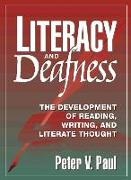Share
Fr. 128.20
Peter V. Paul
Literacy and Deafness
English · Paperback / Softback
Shipping usually within 3 to 5 weeks
Description
This is the only available text that presents a comprehensive, balanced view of deafness and literacy. It provides many examples of instructional techniques and presents the theoretical and research rationale for such techniques. The text discusses literacy in light of clinical and cultural perspectives on deafness. Explanations of some of the major theoretical foundations of literacy and deafness are presented clearly and with detail; metatheories, theories, and research data are discussed in an accessible style. Coverage on reading and writing in English as a first and as a second language for hearing students and for students with severe to profound hearing impairment. The text also introduces students to the new, compelling ideas in literary critical fields, which are necessary for understanding the call for ASL / English bilingual programs and notions as empowerment, accessibility, and oppression as they relate to deaf individuals.
List of contents
All chapters conclude with “A Final Word” and “Further Readings.”
Preface.
1.Introduction to Literacy and Deafness.
Metatheorizing in Literacy and Deafness.
Perspectives on Literacy.
Two World-Views for Theorizing, Research, and Instruction.
Discussion of Deafness.
Overview of Literacy Achievement and Deafness.
2.Reading-Comprehension Perspective: Theories and Research on Hearing Students.
Reading-Comprehension Framework: The Notion of Models.
Bottom-Up Models.
Top-Down Models.
Interactive Models.
Research on Reading-Comprehension and Hearing Students: A Summary.
3.Reading-Comprehensive Perspective: Research on Students Who Are Deaf.
Perspectives on Reading Achievement and Deafness.
Select Subgroups.
Research on Selected Text-Based Variables.
Research on Selected Reader-Based Variables.
4.The Development of Writing.
Models of Writing.
Critique of the Three Broad Theoretical Views.
Research on Written Language and Hearing Students.
Stages of Written Language Development.
Research on Written Language and Students Who Are Deaf.
The Reading-Writing Connection: Future Directions.
5.Literary Critical Perspectives.
Critical Theory: A Brief Introduction.
Critical Theory and Literacy.
Clinical and Cultural Perspectives.
6.Second-Language Literacy.
Bilingualism and Second-Language Learning: Description.
Theories of Second-Language Learning and Second-Language Literacy.
The Development of L1 and L2: Similar or Different?
Type of Student and Language Goal.
Synthesis of Research.
The Notion of Transfer.
ASL and Second-Language Literacy: Remarks and Future Research.
7.Instruction and First-Language Literacy, [Martha G. Gaustad, Bowling Green State University; Peter V. Paul, The Ohio State University].
General Instructional Issues.
The Emergence of Literacy Skills: Focus on Typical Readers/Writers.
Beginning Literacy and Children Who are Deaf.
Instruction: Actions for Meeting Literacy Readiness.
Instruction for Classroom Development of Literacy Skills.
8.Instruction and Second-Language Literacy [Peter V. Paul & Martha G. Gaustad].
Selection of Students and Teachers.
Curricular and Instructional Issues.
Use of ASL in Teaching English.
ASL/English Bilingual Education: Some Considerations.
9.Literacy Assessment: Selected Issues.
General Issues of Assessment.
Assessment: Purpose and Use.
A Few Assessment Issues Related to Deafness.
Characteristics of Good Assessment Tools.
Categories of Literacy Assessment.
10.Literacy, Literate Thought, and Deafness: A Brief Synthesis.
Effects of Metatheory and Metatheorizing.
Reciprocal Relation Between Conversational and Written Forms.
Appendix A: Comprehension Questions and Challenge Questions.
Appendix B: Suggested Books and Materials for Children and Adolescents.
References.
Index.
Summary
This is the only available text that presents a comprehensive, balanced view of deafness and literacy. It provides many examples of instructional techniques and presents the theoretical and research rationale for such techniques. The text discusses literacy in light of clinical and cultural perspectives on deafness. Explanations of some of the major theoretical foundations of literacy and deafness are presented clearly and with detail; metatheories, theories, and research data are discussed in an accessible style. Coverage on reading and writing in English as a first and as a second language for hearing students and for students with severe to profound hearing impairment. The text also introduces students to the new, compelling ideas in literary critical fields, which are necessary for understanding the call for ASL / English bilingual programs and notions as empowerment, accessibility, and oppression as they relate to deaf individuals.
Product details
| Authors | Peter V. Paul |
| Publisher | Pearson Academic |
| Languages | English |
| Product format | Paperback / Softback |
| Released | 01.01.1997 |
| EAN | 9780205175765 |
| ISBN | 978-0-205-17576-5 |
| No. of pages | 358 |
| Weight | 1030 g |
| Series |
Allyn & Bacon Allyn & Bacon |
| Subject |
Humanities, art, music
> Education
> Special education
|
Customer reviews
No reviews have been written for this item yet. Write the first review and be helpful to other users when they decide on a purchase.
Write a review
Thumbs up or thumbs down? Write your own review.

